Investigations of Energy Conversion and Surface Effect for Laser-Illuminated Gold Nanorod Platforms
Abstract
:1. Introduction
2. Theoretical Models
2.1. CFD Governing Equations
2.2. Energy Conversion Rate
2.3. Cross-Sections and Polarizability
2.4. Surface Effect
3. Methodology
3.1. Considered System
3.2. Calculations of Energy Conversion Rate
3.3. Numerical Model Implementations and Mesh Independences’ Proceedings
- —Relative error between two sets/values of data;
- —Continuum value as if the mesh or time size equals zero;
- —Constant or a function of the selected quantity that is other than ;
- —Factor of safety, here: 1.25.
3.4. Boundary Conditions
4. Results
4.1. Mesh and Time Independence Tests
4.2. Experimental Validation
4.3. CFD Results for 0.5 W Laser Illumination
4.3.1. Heating Stage
4.3.2. Cooling Stage
4.3.3. Time Responses
4.4. Discussion
5. Conclusions and Perspectives
Author Contributions
Funding
Data Availability Statement
Acknowledgments
Conflicts of Interest
Nomenclature
| Roman letters | |
| absorption coefficient of nanoparticles, | |
| absorption coefficient of the continuous material, | |
| constant | |
| absorption cross-section of the -particle, | |
| extinction cross-section of the -particle, | |
| scattered cross-section of the -particle, | |
| effective heat capacity, | |
| specific heat capacity, | |
| symmetric rate of deformation, | |
| longer diameter of the -nanoparticle, | |
| size of the nanoparticle’s coating, | |
| shorter diameter of the -nanoparticle, | |
| specific energy, | |
| factor of safety, here: 1.25 | |
| selected quantity or testing parameter, here: temperature, | |
| turbulence kinetic energy generation due to velocity gradients, | |
| turbulence kinetic energy generation due to buoyancy forces, | |
| gravity, | |
| numerical parameters to be compared (here: mesh size or timestep) | |
| heat transfer coefficient, | |
| laser intensity profile at its maximum | |
| initial laser intensity profile, | |
| absorbed part of the -particle, | |
| effective thermal conductivity coefficient, | |
| refractive index of selected material, - | |
| numerical constant for 3- correction, - | |
| turbulent Prandtl number for kinetic energy, - | |
| turbulent Prandtl number for rate of dissipation, - | |
| Prandtl number, - | |
| pressure, | |
| reflection coefficient of nanoparticles, - | |
| reflection coefficient of the continuous material, - | |
| beam size of laser source, here: 0.0015 | |
| radius in spherical coordinates, | |
| source of energy for fluids, | |
| source of energy for the -particle, | |
| initial temperature at the , | |
| temperature, | |
| time, | |
| distance between particles from their boundaries, | |
| speed of sound, | |
| velocity of the fluid, | |
| size distribution (polydispersity), according to the Gaussian distribution, - | |
| length distribution (polydispersity), according to the Gaussian distribution, - | |
| distance distribution, according to the Lorentzian distribution, - | |
| diffusive momentum flux, | |
| Cartesian’s coordinates, | |
| Greek letters | |
| effective polarizability of the -particle, | |
| polarizability of the -particle, | |
| anisotropic factor for distance and surface effects, | |
| gold slab thickness, here: size of capped nanoparticles, | |
| thickness of the considered material, | |
| permittivity in vacuum, - | |
| relative permittivity of the considered metal, - | |
| relative permittivity of the core, here: , | |
| relative permittivity of the capping agent, | |
| relative permittivity of the working (host) medium, - | |
| relative permittivity of the base where NRs are deposited, - | |
| relative emissivity, - | |
| rank of accuracy, here: | |
| relative error, - | |
| incident wavelength, | |
| molecular viscosity, | |
| nanoparticles concentration, | |
| density of a material, | |
| surface tension parameter, | |
| elongation parameter, - | |
| Slavic letters | |
| thermal expansion coefficient, | |
| relaxation time, | |
| Others | |
| symbol of partial derivative | |
| turbulent energy dissipation, | |
| fractional error | |
| symmetrical rate of prolate rod–surface interaction | |
| first invariant of the strain rate, | |
| unit tensor, | |
| symbol of imaginary unit | |
| imaginary part of a complex expression | |
| turbulent kinetic energy | |
| number of NP-NP pairs | |
| associated Legendre polynomials of a first kind | |
| associated Legendre polynomials of a second kind | |
| total specific entropy, | |
| real part of a complex expression | |
| boundary for size distribution, - | |
| boundary for length distribution, - | |
| boundary for distance distribution | |
| Subscripts and superscripts | |
| aurum, gold | |
| air | |
| core | |
| fluid | |
| g | agent (shell) |
| size distribution | |
| selected axis | |
| length distribution | |
| distance distribution between nanoparticles | |
| long | |
| material | |
| in reference to initial conditions | |
| safety | |
| short | |
| step | |
| turbulent | |
| , | integers of Legendre polynomials’ association |
| transposition | |
| parallel | |
| perpendicular | |
| average value | |
| oriented axis | |
| − | unoriented axis |
| Abbreviations | |
| absorption | |
| average | |
| CFD | computational fluid dynamics |
| CPU | central processing unit |
| divergence | |
| effective | |
| exponent | |
| extinction | |
| FVM | finite volume method |
| grid convergence index | |
| glass | |
| gradient | |
| maximum | |
| minimum | |
| nanoparticle | |
| NRs | nanorods |
| PEL | polyelectrolyte |
| phonon | |
| quantified | |
| scattering | |
| surface | |
| in reference to the Yamaguchi approach |
References
- Coyle, E.D.; Simmons, R.A. Understanding the Global Energy Crisis; Purdue University Press: West Lafayette, IN, USA, 2014. [Google Scholar]
- Huang, Y.; Lee, C.K.C.; Yam, Y.-S.; Mok, W.-C.; Zhou, J.L.; Zhuang, Y.; Surawski, N.C.; Organ, B.; Chan, E.F.C. Rapid detection of high-emitting vehicles by on-road remote sensing technology improves urban air quality. Sci. Adv. 2022, 8, eabl7575. [Google Scholar] [CrossRef] [PubMed]
- Petronella, F.; De Biase, D.; Zaccagnini, F.; Verrina, V.; Lim, S.; Jeong, K.; Miglietta, S.; Petrozza, V.; Scognamiglio, V.; Godman, N.P.; et al. Label-free and reusable antibody-functionalized gold nanorod arrays for the rapid detection of Escherichia coli cells in a water dispersion. Environ. Sci. Nano 2022, 9, 3343–3360. [Google Scholar] [CrossRef]
- Zaccagnini, F.; Radomski, P.; Sforza, M.L.; Ziółkowski, P.; Lim, S.I.; Jeong, K.U.; Mikielewicz, D.; Godman, N.P.; Evans, D.R.; Slagle, J.E.; et al. White light termoplasmonic activated gold nanorod arrays enable the photo-thermal disinfection of medical tools from bacterial contamination. J. Mater. Chem. B 2023, 11, 6823–6836. [Google Scholar] [CrossRef] [PubMed]
- Fang, X.; Wang, Y.; Wang, Z.; Jiang, Z.; Dong, M. Microorganism Assisted Synthesized Nanoparticles for Catalytic Applications. Energies 2019, 12, 190. [Google Scholar] [CrossRef]
- Pontico, M.; Conte, M.; Petronella, F.; Frantellizzi, V.; De Feo, M.S.; Di Luzio, D.; Pani, R.; De Vincentis, G.; De Sio, L. 18F-fluorodeoxyglucose (18F-FDG) Functionalized Gold Nanoparticles (GNPs) for Plasmonic Photothermal Ablation of Cancer: A Review. Pharmaceutics 2023, 15, 319. [Google Scholar] [CrossRef] [PubMed]
- Radomski, P.; Ziolkowski, P.; Mikielewicz, D. Energy conversion in systems-contained laser irradiated metallic nanoparticles—Comparison of results from analytical solutions and numerical methods. Acta Mech. Autom. 2023, 17, 540–549. [Google Scholar] [CrossRef]
- Tofani, K.; Tiari, S. Nano-Enhanced Phase Change Materials in Latent Heat Thermal Energy Storage Systems: A Review. Energies 2021, 14, 3821. [Google Scholar] [CrossRef]
- Mebared-Oudina, F.; Chabani, I. Revie on Nano Enhanced PCMs: Insight on nePCM Application in Thermal Management/Storage Systems. Energies 2023, 16, 1066. [Google Scholar] [CrossRef]
- Radomski, P.; Ziolkowski, P.; De Sio, L.; Mikielewicz, D. Computational fluid dynamics simulation of heat transfer from densely packed gold nanoparticles to isotropic media. Arch. Thermodyn. 2021, 42, 87–114. [Google Scholar]
- Mikielewicz, D. Hydrodynamics and heat transfer in bubbly flow in the turbulent boundary layer. Int. J. Heat Mass Transf. 2002, 46, 207–220. [Google Scholar] [CrossRef]
- Ziolkowski, P.; Badur, J. A theoretical, numerical and experimental verification of the Reynolds thermal transpiration law. Int. J. Numer. Methods Heat Fluid Flow 2018, 28, 64–80. [Google Scholar] [CrossRef]
- De Sio, L.; Placido, T.; Comparelli, R.; Curri, M.L.; Striccoli, M.; Tabiryan, N.; Bunning, T.J. Next-generation thermo-plasmonic technologies and plasmonic nanoparticles in optoelectronics. Prog. Quantum Electron. 2015, 41, 23–70. [Google Scholar] [CrossRef]
- Sobhan, C.B.; Peterson, G.P. Microscale and Nanoscale Heat Transfer: Fundamentals and Engineering Applications; CRC Press: Boca Raton, FL, USA; Taylor & Francis Group: Abingdon, UK, 2008. [Google Scholar]
- Cattaneo, M.C. A form of heat conduction equation which eliminates the paradox of instantaneous propagation. Compte Rendus 1958, 247, 431–433. [Google Scholar]
- Radomski, P.; Zaccagnini, F.; Ziolkowski, P.; Petronella, F.; De Sio, L.; Mikielewicz, D. Heat Transfer of the Multicolor-Laser-Sources-Irradiated Nanoparticles in Reference to Thermal Processes. In Proceedings of the 36th International Conference on Efficiency, Cost, Optimization, Simulation and Environmental Impact on Energy Systems (ECOS), Las Palmas de Gran Canaria, Spain, 25–30 June 2023. [Google Scholar]
- Bohren, C.F.; Huffman, D.R. Absorption and Scattering of Light by Small Particles; A Wiley-Interscience Publication: Toronto, ON, Canada, 1998. [Google Scholar]
- Strutt, H.J.W. On the scattering of light by small particles. Lond. Edinb. Dublin Philos. Mag. J. Sci. 1871, 41, 447–454. [Google Scholar] [CrossRef]
- Smoluchowski, M. On conduction of heat by rarefied gases. Ann. Phys. Chem. 1898, 64, 101–130. (In German) [Google Scholar]
- Kreibig, U.; Vollmer, M. Optical Properties of Metal Clusters; Springer Series in Material Science; Springer: New York, NY, USA, 1995. [Google Scholar]
- Yamaguchi, T.; Yoshida, S.; Kinbara, A. Optical Effect of the Substrate on the Anomalous Absorption of Aggregated Silver Films. Thin Solid Film. 1974, 21, 173–187. [Google Scholar] [CrossRef]
- Fuchs, R. Theory of the optical properties of ionic crystal cubes. Phys. Rev. B 1975, 11, 1732–1740. [Google Scholar] [CrossRef]
- Roache, P.J. Quantification of Uncertainty in Computational Fluid Dynamics. Annu. Rev. Fluid Mech. 1997, 29, 123–160. [Google Scholar] [CrossRef]
- Richardson, L.F. The approximate arithmetical solution by finite differences of physical problems including differential equations, with an application to the stresses in a masonry dam. Phylosophical Trans. R. Soc. A 1911, 210, 307–357. [Google Scholar]
- Domański, R. Laser Radiation—Solid-State Interaction; Polish Scientific-Technical Journals: Warsaw, Poland, 1990; pp. 130–220. ISBN 83-204-1383-4. (In Polish) [Google Scholar]
- Carslaw, H.S.; Jaeger, J.C. Conduction of Heat in Solids, 2nd ed.; Oxford University Press: London, UK, 1959; pp. 50–132. [Google Scholar]
- Romanchuk, B.J. Computational Modeling of Buble Growth Dynamics in Nucleate Pool Boiling for Pure Water and Aqueous Surfactant Solutions. Master’s Thesis, Division of Research and Advanced of the University of Cincinnati, Cincinnati, OH, USA, 2014. [Google Scholar]
- Darbari, B.; Rashidi, S.; Esfahani, J.A. Sensitivity Analysis of Entropy Generation in Nanofluid Flow inside a Channel by Response Surface Methodology. Entropy 2016, 18, 52. [Google Scholar] [CrossRef]
- Nisar, K.S.; Khan, D.; Khan, A.; Khan, W.A.; Khan, I.; Aldawsari, A.M. Entropy Generation and Heat Transfer in Drilling Nanoliquids with Clay Nanoparticles. Entropy 2019, 21, 1226. [Google Scholar] [CrossRef]
- Zhang, L.; Bhatti, M.M.; Marin, M.; Mekheimer, K.S. Entropy Analysis on the Blood Flow through Anisotropically Tapered Arteries Filled with Magnetic Zinc-Oxide (ZnO) Nanoparticles. Entropy 2020, 22, 1070. [Google Scholar] [CrossRef] [PubMed]
- Ziolkowski, P.; Badur, J. On Navier slip and Reynolds transpiration numbers. Arch. Mech. 2018, 70, 269–300. [Google Scholar]
- Vial, A.; Laroche, T. Description of dispersion properties of metals by means of the critical points model and application to the study of resonant structures using the FDTD method. J. Phys. D Appl. Phys. 2007, 40, 7152–7158. [Google Scholar] [CrossRef]
- Bengte, D.L. The Refractive Index of Air. Metrologia 1966, 8, 71–80. [Google Scholar]
- Bansal, N.P.; Doremus, R.H. Handbook of Glass Properties; Academic Press: Cambridge, MA, USA; Materials Engineering Department Rensselaer Polytechnic Institute: Troy, NY, USA, 1986. [Google Scholar]
- Zaitlin MP Anderson, A.C. Thermal Conductivity of Borosilicate Glass. Phys. Rev. Lett. 1974, 33, 1158–1161. [Google Scholar] [CrossRef]
- Mark, J.E. Polymer Data Handbook; Oxford University Press: London, UK, 1999; Volume 131, p. 44. [Google Scholar]
- Reddy, H. Temperature-dependent optical properties of gold thin films. Opt. Mater. Express 2016, 6, 2776–2802. [Google Scholar] [CrossRef]
- Siegel, R.; Howell, J.R. Thermal Radiation Heat Transfer; McGraw-Hill Book Company: New York, NY, USA, 1972. [Google Scholar]
- Engineering ToolBox. Air—Density, Specific Weight and Thermal Expansion Coefficient vs. Temperature and Pressure. 2003. Available online: https://www.engineeringtoolbox.com/air-density-specific-weight-d_600.html (accessed on 17 February 2023).
- Engineering ToolBox. Air—Thermal Conductivity vs. Temperature and Pressure. 2009. Available online: https://www.engineeringtoolbox.com/air-properties-viscosity-conductivity-heat-capacity-d_1509.html (accessed on 17 February 2023).
- Engineering ToolBox. Air—Dynamic and Kinematic Viscosity. 2003. Available online: https://www.engineeringtoolbox.com/air-absolute-kinematic-viscosity-d_601.html (accessed on 17 February 2023).
- Fernández-Prini, R. Release on the Refractive Index of Ordinary Water Substance as a Function of Wavelength, Temperature and Pressure. J. Phys. Chem. Ref. Data 1998, 27, 761. [Google Scholar]
- Koulali, A.; Ziółkowski, P.; Radomski, P.; De Sio, L.; Zieliński, J.; Mikielewicz, D. Single-Phase CFD Approach for Investingating Bacterial Inactivation and Heat Transfer in a Microchamber; Book of extended papers from XXV Jubilee Congress of Thermodynamics in Gdańsk (Poland), 11–14 September 2023; Gdańsk University of Technology Redaction: Gdańsk, Poland, 2023; pp. 167–174. [Google Scholar]
- Koulali, A.; Abderrahmane, A.; Jamshed, W.; Hussain, S.M.; Nisar, K.S.; Abdel-Aty, A.H.; Yahia, I.S.; Eid, M.R. Comparative study on effects of thermal gradient direction on heat exchange between a pure fluid and a nanofluid: Employing finite volume method. Coatings 2021, 11, 1481. [Google Scholar] [CrossRef]
- Piotrowicz, M.; Flaszynski, P.; Doerffer, P. Effect of Hot Spot Location on Flow Structure in Nozzle Guide Vane. IOP Conf. Ser. J. Phys. Conf. Ser. 2018, 1101, 012025. [Google Scholar] [CrossRef]
- Patthew, P.; Garnett, B. Introduction to Metal-Nanoparticle Plasmonics; A Wiley–ScienceWise Publishing Co-Publication: Hoboken, NJ, USA, 2013. [Google Scholar]
- Zhengdao, W.; Wei, Y.; Qian, Y. Numerical study on entropy generation in thermal convection with differentially discrete heat boundary conditions. Entropy 2018, 20, 351. [Google Scholar] [CrossRef] [PubMed]
- Al-Kouz, W. MHD darcy-forchheimer nanofluid flow and entropy optimization in an odd-shaped enclosure filled with a (MWCNT-Fe3O4/water) using galerkin finite element analysis. Sci. Rep. 2021, 11, 2263. [Google Scholar] [CrossRef] [PubMed]
- Drożyński, Z. Entropy increase as a measure of energy degradation in heat transfer. Arch. Thermodyn. 2013, 34, 147–160. [Google Scholar] [CrossRef]
- Bejan, A. Fundamentals of Exergy Analysis, Entropy Generation Minimization, and the Generation of Flow Architecture. Int. J. Energy Res. 2002, 26, 1–43. [Google Scholar] [CrossRef]
- Sciubba, E. Use of Exergy Analysis To Compute The Resource Intensity of Biological Systems and Human Societies. In Proceedings of the 12th Joint European Thermodynamics Conference, Brescia, Italy, 1–5 July 2013; pp. 268–273. [Google Scholar]
- Jou, D. Entropy, entropy flux, temperature, and second law in extended irreversible thermodynamics. In Proceedings of the 12th Joint European Thermodynamics Conference, Brescia, Italy, 1–5 July 2013; pp. 211–216. [Google Scholar]
- Flaszynski, P.; Wasilczuk, F.; Piotrowicz, M.; Telega, J.; Mitraszewski, K.; Hansen, K.S. Numerical simulations for a parametric study of blockage effect on offshore wind farms. Wind Energy 2023, 27, 53–74. [Google Scholar] [CrossRef]
- Radomski, P.; De Sio, L.; Ziółkowski, P.; Mikielewicz, D. Heat Transfer in a Metallic-Nanoparticles-Contained System Using the Discrete-Ordinates and Thin-Film-Adjusted Models; Book of papers from XXV Jubilee Congress of Thermodynamics in Gdańsk (Poland), 11–14 September 2023; Gdańsk University of Technology Redaction: Gdańsk, Poland, 2023; p. 91. [Google Scholar]
- Zuo, W.; Li, F.; Li, Q.; Chen, Z.; Huang, Y.; Chu, H. Multi-objective optimization of micro planar combustor with tube outlet by RSM and NSGA-II for thermophotovoltaic applications. Energy 2024, 291, 130396. [Google Scholar] [CrossRef]







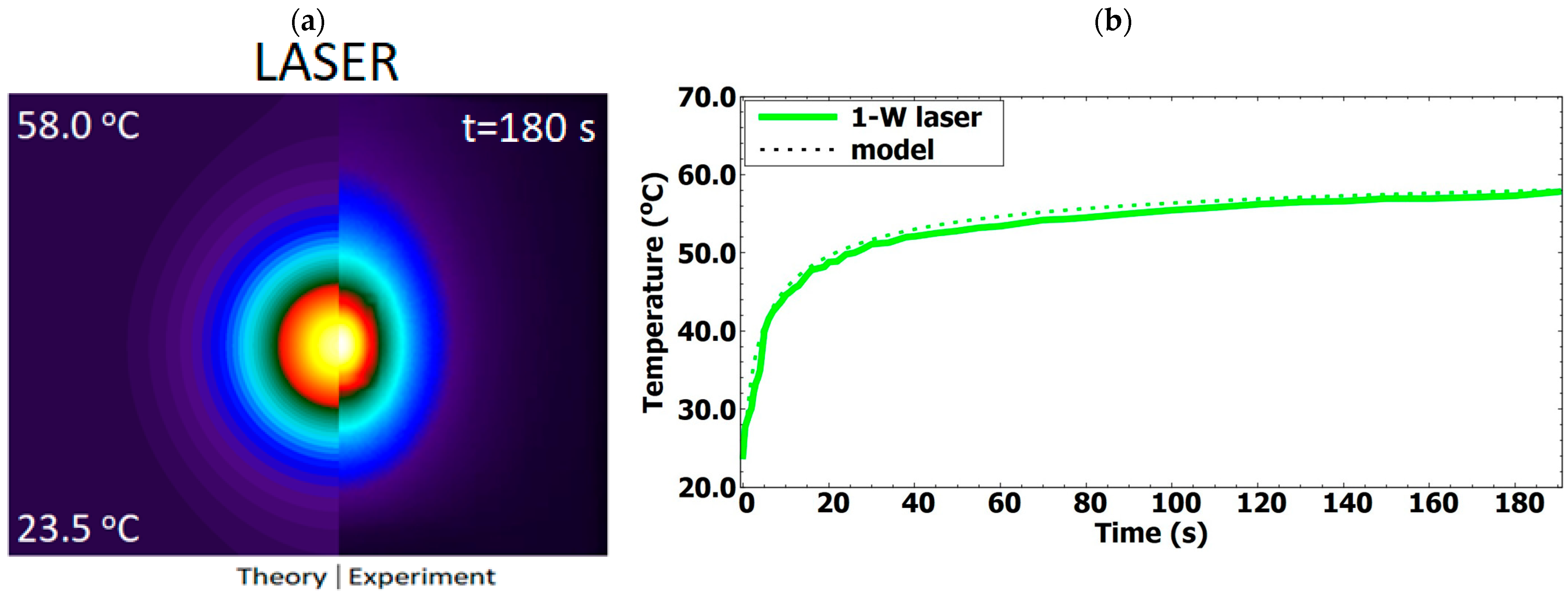
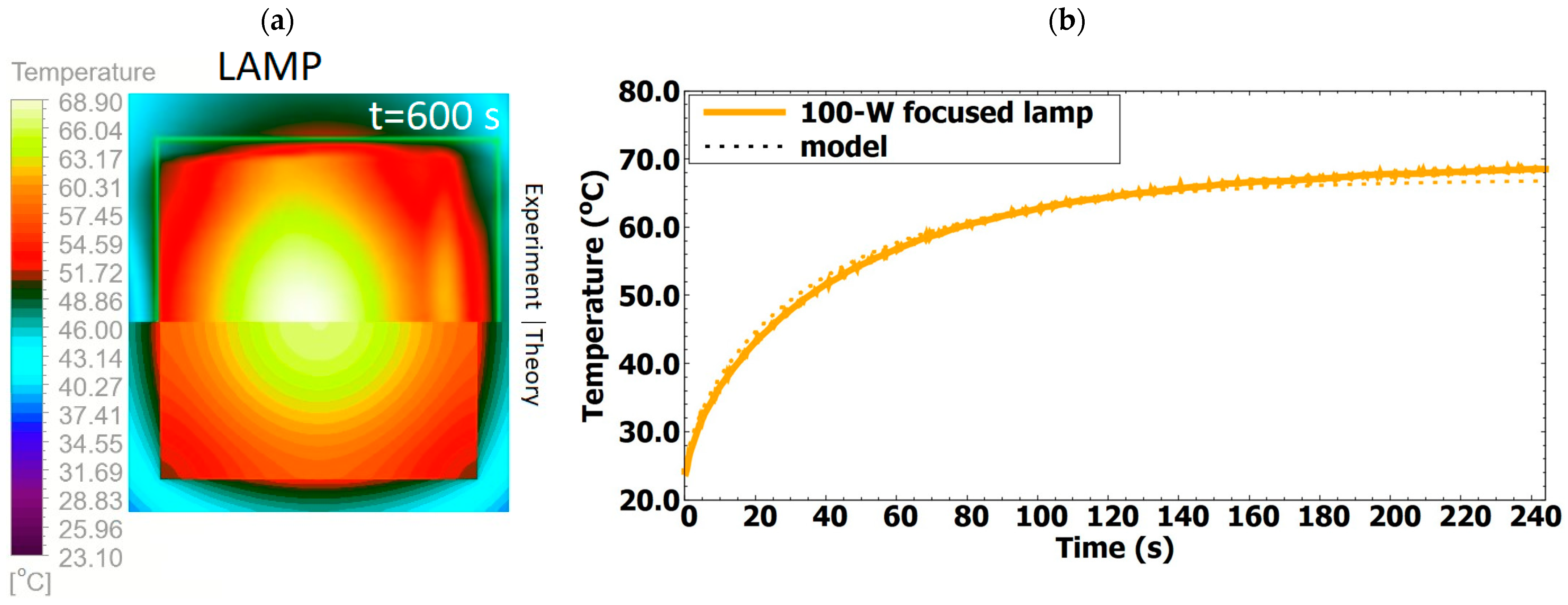
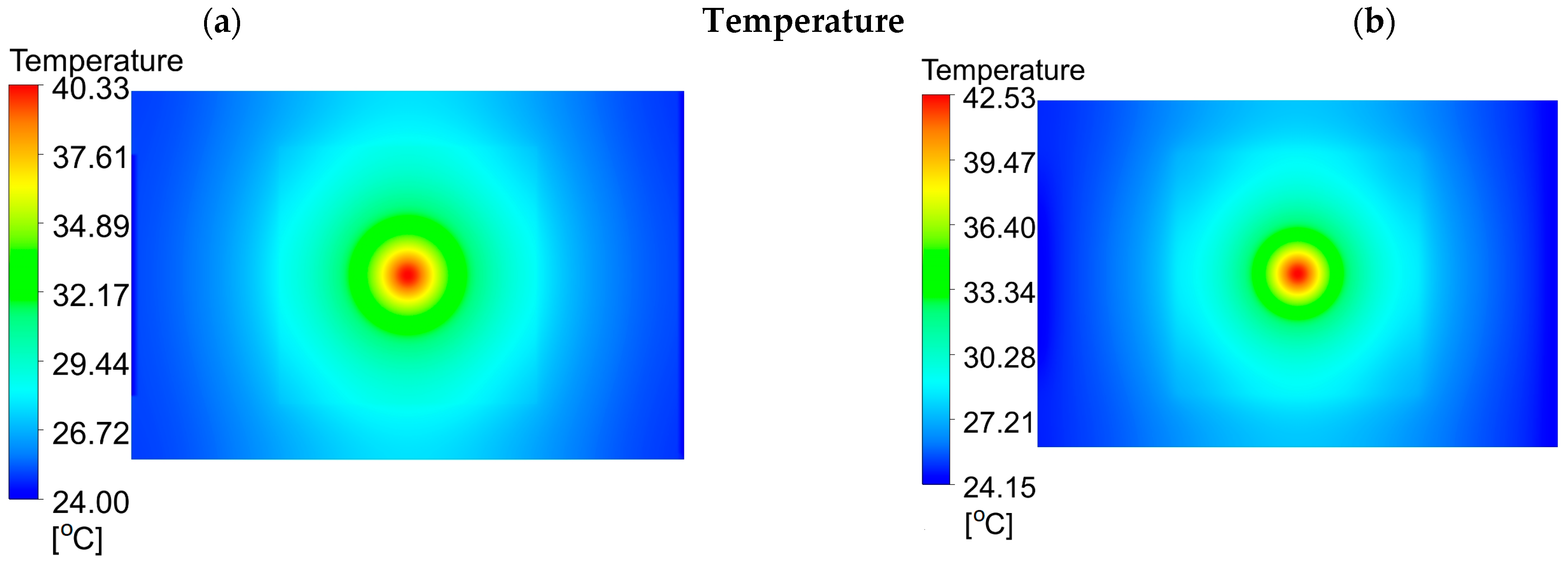


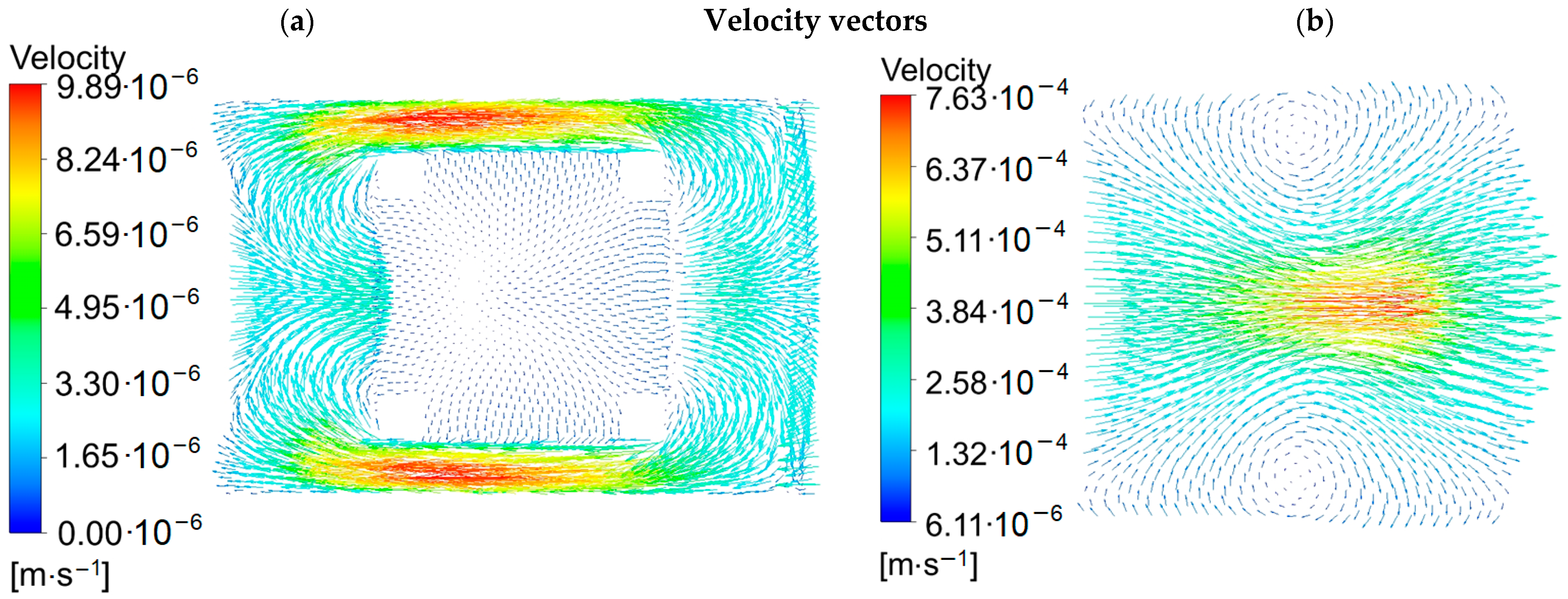
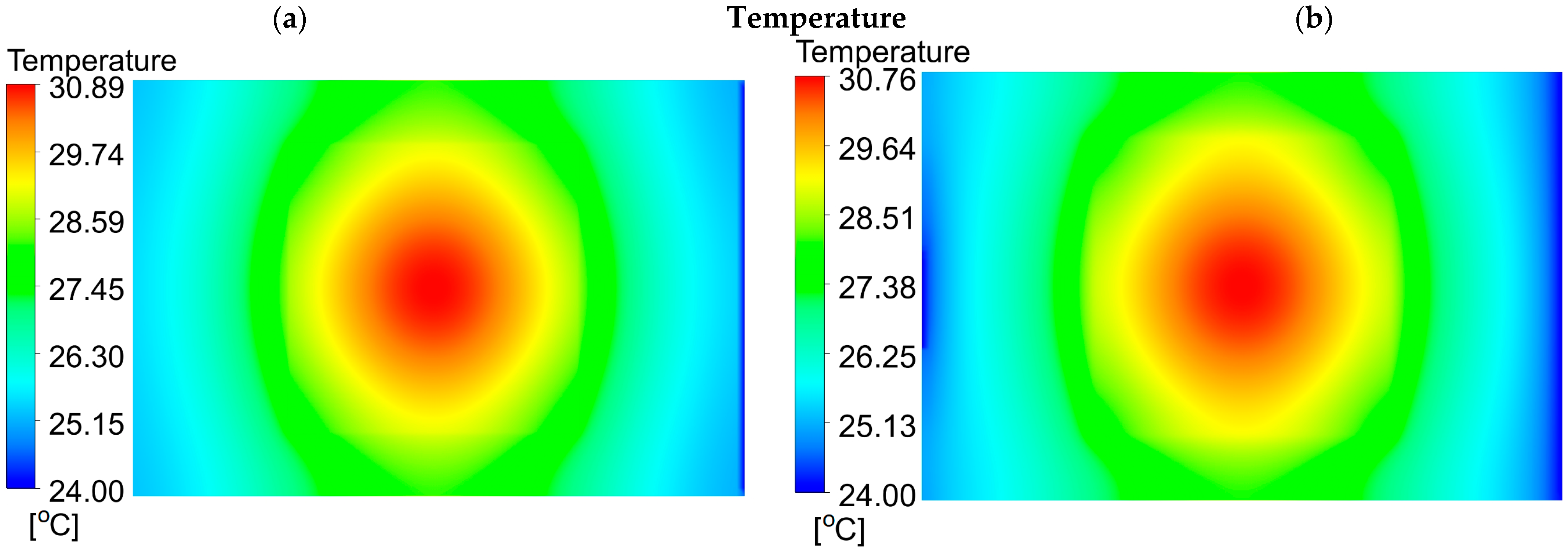


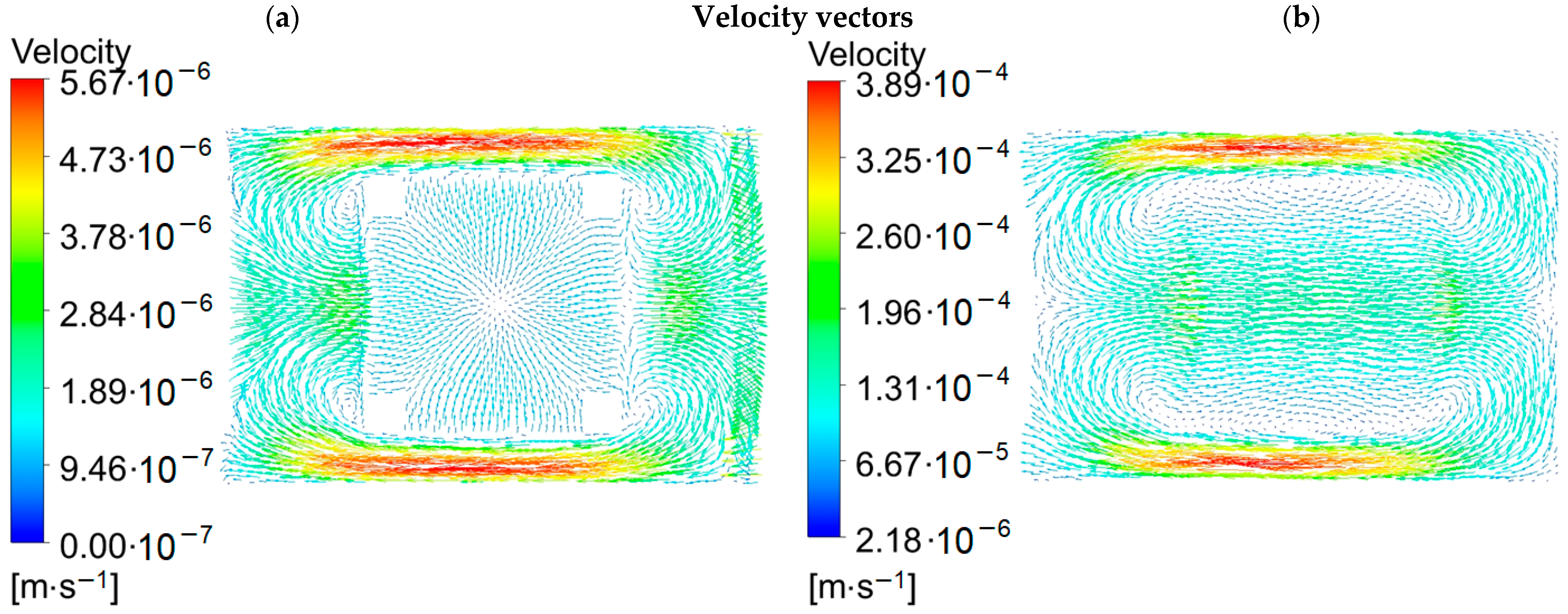

| General Parameter | Assumed Value |
|---|---|
| Expected size of nanorods, | |
| Expected length of nanorods, | |
| Interdistance, | |
| Capping agent thickness, | 4 nm |
| Nanoparticle concentration, |
| Permittivities | References | ||
|---|---|---|---|
| Air, | 1.011639 | [29] | |
| Glass, | 2.281912 | [30,31] | |
| Glue, | 2.400680 | [32] | |
| Polyelectrolyte, | 2.274245 | [4] | |
| Gold nanoparticles | −25.035329 | [33,34] | |
| 1.564609 | |||
| Material | Thermal Conductivity Coefficient, | Dynamic Viscosity, | References | ||
|---|---|---|---|---|---|
| Glass | 0.9245251 + 0.0004777689 · T | - | [33,34,35] | ||
| Glue | [36] | ||||
| Gold nanorods | 19,320 | - | [37,38] | ||
| Air | 0.004204762 | [39,40,41,42] |
| No. | Domain | Boundary Conditions | |
|---|---|---|---|
| (1) | Bottom glass | ||
| (2) | Air | (shell conduction) | |
| (at inlet) | |||
| (3) | Glue | ||
| (4) | Top glass | ||
| (5) | Gold slabs | ||
| − | |||
| System | |||
| 1013.25 hPa | |||
| Parameter | Mesh 1 | Mesh 2 | Mesh 3 |
|---|---|---|---|
| Mean mesh size | |||
| Maximum aspect ratio | |||
| Mean volume cell | |||
| Orthogonal quality | |||
| Number of cells |
| Extrapolated Error | Mesh 1–Mesh 2 | Mesh 2–Mesh 3 | – | – | |
|---|---|---|---|---|---|
| 51.5538 °C | 51.8365 °C | 52.2260 °C | 52.1884 °C | ||
| 25.7018 °C | 25.7018 °C | 25.7018 °C | 25.7046 °C | ||
| 51.8277 °C | 51.7884 °C | ||||
| 25.7018 °C | 25.7018 °C | ||||
Disclaimer/Publisher’s Note: The statements, opinions and data contained in all publications are solely those of the individual author(s) and contributor(s) and not of MDPI and/or the editor(s). MDPI and/or the editor(s) disclaim responsibility for any injury to people or property resulting from any ideas, methods, instructions or products referred to in the content. |
© 2024 by the authors. Licensee MDPI, Basel, Switzerland. This article is an open access article distributed under the terms and conditions of the Creative Commons Attribution (CC BY) license (https://creativecommons.org/licenses/by/4.0/).
Share and Cite
Radomski, P.; Zaccagnini, F.; Ziółkowski, P.; Petronella, F.; De Sio, L.; Koulali, A.; Mikielewicz, D. Investigations of Energy Conversion and Surface Effect for Laser-Illuminated Gold Nanorod Platforms. Energies 2024, 17, 2587. https://doi.org/10.3390/en17112587
Radomski P, Zaccagnini F, Ziółkowski P, Petronella F, De Sio L, Koulali A, Mikielewicz D. Investigations of Energy Conversion and Surface Effect for Laser-Illuminated Gold Nanorod Platforms. Energies. 2024; 17(11):2587. https://doi.org/10.3390/en17112587
Chicago/Turabian StyleRadomski, Piotr, Federica Zaccagnini, Paweł Ziółkowski, Francesca Petronella, Luciano De Sio, Aimad Koulali, and Dariusz Mikielewicz. 2024. "Investigations of Energy Conversion and Surface Effect for Laser-Illuminated Gold Nanorod Platforms" Energies 17, no. 11: 2587. https://doi.org/10.3390/en17112587





